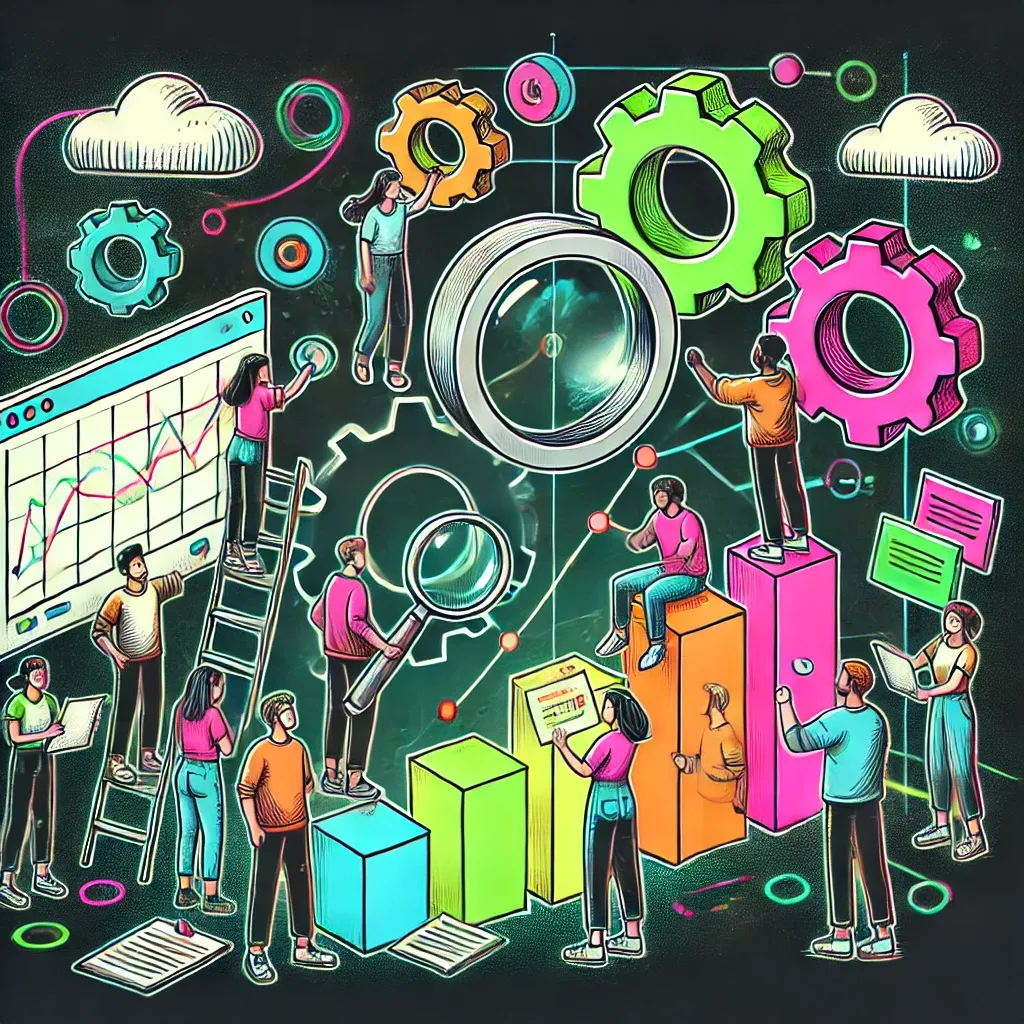How to Measure Team Collaboration Effectively: Metrics, Strategies, and Tools
Learn how to measure team collaboration effectively with key metrics, strategies, and tools. Understand the difference between true collaboration and co-acting, and discover how to foster trust, improve engagement, and boost team performance

Collaboration—When it works, it’s magic.
When it doesn’t, it’s like trying to navigate a minefield while blindfolded, with people yelling conflicting directions while they’re all busy checking their email—just a bunch of people nodding in meetings without a clue what’s going on.
Teams that collaborate well are not only more productive but also have higher levels of employee satisfaction and overall success.
However, measuring collaboration can be challenging due to its intangible nature.
This article explores why measuring collaboration is essential, the key metrics to consider, and the tools and strategies that can help organizations foster better teamwork.
🔑 Key Takeaways 🔑
- Effective team collaboration goes beyond mere co-acting; it requires active engagement, shared learning, and meaningful support.
- Measuring collaboration helps assess its impact on productivity, employee satisfaction, and business outcomes.
- Key metrics to track include engagement, participation, quality of interactions, and knowledge sharing.
- Digital tools like Kanban boards, Gantt charts, and reporting dashboards provide valuable data-driven insights into team dynamics.
- Fostering a culture of trust, open communication, and cross-functional collaboration are vital for enhancing teamwork.
Understanding the Intent Behind Measuring Team Collaboration
Collaboration isn’t just sitting next to each other in an open office.
It’s about sharing the brain load, asking for help before your code becomes a flaming dumpster fire, and actually listening when someone says, 'I think there’s a better way.'
True collaboration requires team members to actively engage, support each other, and contribute unique perspectives.
Leaders should model these behaviors during team activities like retrospectives and sprint planning to foster an environment of continuous learning.
Encouraging team members to openly share uncertainties during meetings is an effective strategy for fostering vulnerability and group learning.
For example, admitting that you're stuck on a bug you can't fix or that you don’t fully understand a new feature can open the door to more honest conversations.
This can be done by creating a safe space where team members feel comfortable expressing their doubts and challenges, which helps build trust and facilitates deeper collaboration.
Additionally, promoting retrospectives where individuals can discuss what they don’t know and what they’ve learned can further enhance group learning and cohesion.
Measuring collaboration helps organizations understand its impact on productivity, employee engagement, and overall business outcomes.
For example, tracking customer satisfaction can provide insights into how well collaboration is affecting customer interactions and service quality, while monitoring employee attrition rates can help assess whether a collaborative environment is contributing to employee retention.
These data-driven metrics offer clear, quantitative measures of collaboration effectiveness, similar to the approaches highlighted by RallyBright.
Effective collaboration leads to better decision-making, higher revenue, and improved customer satisfaction.
By measuring collaboration, companies can identify areas for improvement and ensure teams are working cohesively towards common goals.
Additionally, understanding collaboration helps foster an environment of trust and psychological safety, which is critical for encouraging vulnerability and open communication among team members.

Key Metrics to Measure Team Collaboration
Engagement and participation are key indicators of effective collaboration.
Tracking engagement isn’t just about making sure people show up to meetings.
It’s about seeing who’s actually contributing and who’s on their fifth 'network connectivity issue' of the day.
Real contributions are critical because they reveal who is actively pushing projects forward and who might need more support or motivation.
Using reporting software or tools like Gantt charts, Kanban boards, and dashboards can help track these metrics more effectively by providing a clear visual representation of each member's workload and progress, as highlighted by Wrike automated reporting.
Dashboards are particularly useful for providing at-a-glance views of key collaboration metrics.
- Key Indicators:
- Involvement
- Responsiveness
- Contributions
- Tools to Track:
- Reporting software
- Gantt charts
- Kanban boards
Employee engagement scores and participation frequency can provide insights into how effectively team members are collaborating.
It is important to focus on the quality of interactions rather than just their frequency.
Overburdening key contributors can lead to burnout, which negatively affects team performance.
Measuring the quality of collaboration ensures that interactions are meaningful and productive.
Tracking the balance of contribution across team members can help identify if certain individuals are overburdened, which can also indicate potential burnout risks.
A real-world example of focusing on the quality of collaboration is seen at Blinds Direct.
They implemented a "Role Switch" event where team members swapped roles with their colleagues for a day.
Blinds Direct's role-switch day gave people a taste of their coworkers' daily grind.
Empathy grew, and so did the realization that maybe everyone’s job is a little harder than it looks.
Fewer complaints and a bit more appreciation across the team never hurts.
This initiative improved the overall quality of collaboration by increasing mutual respect and awareness of workload complexities.
Empathy and mutual respect improve interpersonal relationships, leading to better decision-making and problem-solving.
Team members are more likely to consider diverse perspectives and work together to find the best solutions, which enhances collaboration quality by increasing mutual respect and awareness of workload complexities.
Metrics related to knowledge sharing and help-seeking behaviors are crucial for assessing team collaboration.
This includes tracking contributions to shared knowledge bases and the frequency of help-seeking within the team.
Encouraging help-seeking behaviors is important as it fosters learning, reduces ambiguity, and strengthens trust among team members.
Badger Maps carried out cross-training sessions that helped employees broaden their skill sets and better understand different roles within the team.
This improved knowledge sharing, reduced hand-offs, and enhanced collaboration, which in turn led to better customer satisfaction and increased productivity.
Team performance metrics such as project completion rates, quality of deliverables, and individual productivity help evaluate how well the team is collaborating to meet goals and deadlines.
Additionally, customer satisfaction and the effectiveness of shared deliverables can also serve as indicators of successful collaboration.

Qualitative Methods for Measuring Collaboration
Surveys and peer evaluations provide valuable insights into individual contributions and team dynamics.
They help gauge how well team members perceive their collaboration efforts and identify areas for improvement.
- Questions to Include in Surveys:
- Psychological safety
- Openness
- Willingness to seek and provide help
Observational assessments involve evaluating behaviors such as active listening, participation, and conflict resolution during team meetings.
These assessments can provide qualitative insights into the effectiveness of collaboration.
Managers can observe how team members interact, including whether they ask clarifying questions, offer support, or engage in productive conflict resolution.
An example of observational assessment in action comes from Ford's F-150 development team.
The team used a tightly knit structure with cross-functional collaboration to meet monthly for 18 months, ensuring that innovations were brought together seamlessly.
This approach allowed managers to observe and refine team interactions, resulting in the successful redesign of the F-150 with a significant reduction in weight and increased fuel efficiency.
Tools to Measure Team Collaboration
Project management tools like Kanban boards, Gantt charts, and collaboration dashboards help track progress, facilitate asynchronous work, and provide metrics to evaluate collaboration.
Whether you’re a Trello minimalist or a JIRA maximalist, tools like Gantt charts and Kanban boards can help you track who’s doing what, without having to ask every five minutes—assuming, of course, that people remember to actually update them.
- Tools for Tracking Collaboration:
- Kanban boards: Visual tracking of task progress
- Gantt charts: Tracking timelines and deadlines
- Wrike automated reporting: Measuring performance metrics
- Slack: Monitoring communication frequency
- Trello: Tracking participation in shared activities
These tools offer visibility into the team's workflow and highlight areas that need attention.
Using collaborative virtual spaces allows for real-time and asynchronous communication, which is especially important for distributed teams.
Cross-functional teams can use shared collaboration tools to align different perspectives, create unified goals, and improve communication across departments.
A great example of using collaboration tools is Spotify's Squad and Tribe structure.
Spotify uses small, autonomous teams called Squads, which are part of larger Tribes.
This structure enables cross-functional collaboration while maintaining agility and autonomy.
By using digital tools to track progress and communication, Spotify has been able to innovate rapidly and deliver a high-quality user experience.
Collaboration tools such as communication platforms and project management software provide data-driven insights into engagement, communication frequency, and interaction quality.
| Tool | Purpose | Metric Tracked |
|---|---|---|
| Wrike Reporting | Performance measurement | Task completion rates |
| Slack | Communication tracking | Response times |
| Trello | Activity tracking | Participation in activities |
| Gantt Chart | Progress visualization | Task timelines and dependencies |
Tools like Wrike's automated reporting feature, Gantt charts, Kanban boards, and dashboards offer visual tracking of task progress and performance metrics, providing real-time insights into team dynamics.
Tools like Slack and Trello help track communication frequency and participation in shared activities, giving a comprehensive view of collaboration effectiveness and identifying areas for improvement.

Best Practices for Measuring and Improving Collaboration
Collaboration Checklist for Teams
| Activity | Purpose | Frequency |
|---|---|---|
| Set Clear Expectations | Define roles, responsibilities, and goals | Quarterly |
| Recognition Meetings | Acknowledge team and individual contributions | Monthly |
| One-on-One Check-ins | Discuss challenges and provide support | Bi-weekly |
| Retrospectives | Reflect on recent work to identify improvements | After each project |
| Team-Building Activities | Build trust and strengthen interpersonal bonds | Quarterly |
| Cross-Functional Collaboration | Align goals across different departments | As needed |
| Feedback Sessions | Collect insights on what is working/not working | Monthly |
Setting clear goals and key performance indicators (KPIs) is essential for measuring collaboration effectively.
Teams should be aware of these targets so they can align their efforts accordingly.
- Examples of KPIs:
- Project completion rates
- Customer satisfaction
- Employee retention
- Engagement scores
KPIs make sure everyone knows what winning looks like.
By sharing these goals with the team, you create transparency and alignment, ensuring that everyone is working towards the same objectives.
KPIs such as customer satisfaction, project completion rates, and employee retention offer a quantitative approach to assess the effectiveness of collaboration.
Open and transparent communication is vital for fostering collaboration within a team.
Effective communication ensures that team members are well-informed, understand expectations, and feel comfortable sharing their ideas and concerns.
Leaders should create an environment that encourages and rewards open communication by fostering trust and openness through:
- Regular Team Meetings: Hold regular meetings to discuss project updates, challenges, and potential solutions.
- One-on-One Check-ins: Provide individual support and understand personal challenges that might affect collaboration.
- Anonymous Feedback Channels: Create anonymous surveys or suggestion boxes to make it easier for team members to voice concerns without fear of judgment.
Encouraging open and honest communication ensures that team members feel heard and valued, which is crucial for effective collaboration.
Otherwise, they just start nodding along in meetings—again.
Leaders should also model vulnerability by admitting uncertainties and seeking input from the team, helping to create a culture of trust and openness.
Cross-functional collaboration brings together team members from different departments to work towards a shared goal.
This type of collaboration fosters diverse perspectives, innovative problem-solving, and a more cohesive organizational culture.
- Strategies for Cross-Functional Collaboration:
- Use shared project management tools to track progress and ensure alignment across departments.
- Hold regular alignment meetings to discuss shared objectives and the contributions of each team.
- Establish cross-functional project leads to manage communication and task delegation between teams.
Cross-functional teams can provide unique insights that enhance collaboration and ensure that diverse skill sets are leveraged effectively to achieve the best outcomes.
Conclusion
Effective collaboration is vital to achieving team and organizational success.
By measuring collaboration using the metrics, methods, and tools discussed, organizations can create more aligned and engaged teams.
Otherwise, you risk ending up with a group of people who are just pretending to work well together—until things inevitably fall apart.
Improved collaboration leads to better performance, increased employee well-being, and positive business outcomes.
So measure that collaboration, build that trust, and who knows?
Maybe next time you’ll leave the meeting actually knowing what’s going on.
FAQs
What Are the Most Important Metrics for Measuring Team Collaboration?
The most important metrics include engagement, participation, quality of interactions, knowledge sharing, and team performance metrics such as project completion rates and deliverable quality.
How Can I Use Technology to Measure Team Collaboration Effectively?
Technology-based tools like project management software, communication platforms, and collaboration dashboards can provide data-driven insights into team engagement, communication patterns, and productivity.
Why is Trust Important for Team Collaboration?
Trust fosters an environment where team members feel comfortable sharing ideas, seeking help, and contributing fully to the team's success. Without trust, collaboration becomes superficial and less effective. Encouraging vulnerability and fostering psychological safety are key to building a trusting environment.




